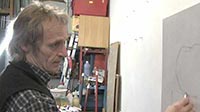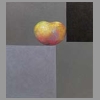
Painted mind
The Vase or Subversion of Simplicity
There are many advantages in the use of such a simple object as a vase. In its plain, archaic form it remains open for almost every modification, be it in colour or in form. In addition universal recognition can be used as an effect and therefore open up the vision behind the object as such.
If I paint a vase large enough so that it threatens to destroy the format, the perception automatically transgresses the object “vase” and remains searching for different clues. The same can happen when the “object” is confronted with geometrical forms. As the elements in my paintings are neither strongly distorted nor expressively overemphasised, they first of all appear perfectly “normal.” But then after a while the contradiction between the daily habit of perception and the representation of the painting takes effect.
The vase previously identified as a simple form is positioned in front of two surfaces for example which obtain their presence only through their colour, while the vase still requires some spatiality. Which habit is the eye to follow? Is it to look for a coloured abstract effect in the vase itself or rather construct a special analogy to it out of the coloured surfaces? A gap opens between what is visible and what is perceived. The instance that both the vase and the coloured areas appear very matter of fact like, almost creating a picturesque unity therefore, widens the gap, once occurred, even further.
The gap developing, between what is material on the painting and how our habit to see changes that, consists of the essential effect in my work; It constitutes of the open space that makes the painting a painting, which exclusively belongs to those who know how to use it, namely the spectators

Videoportrait







































